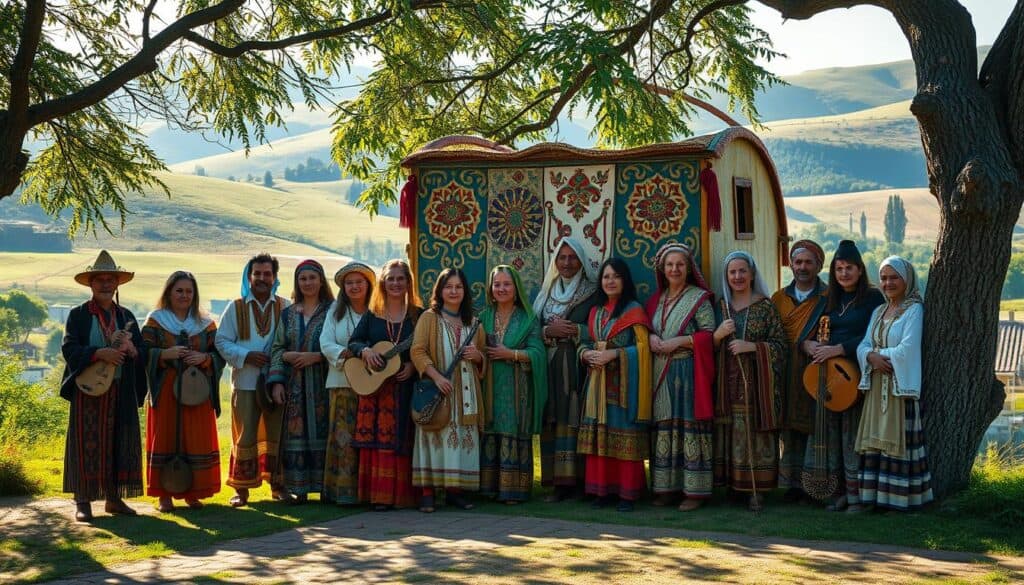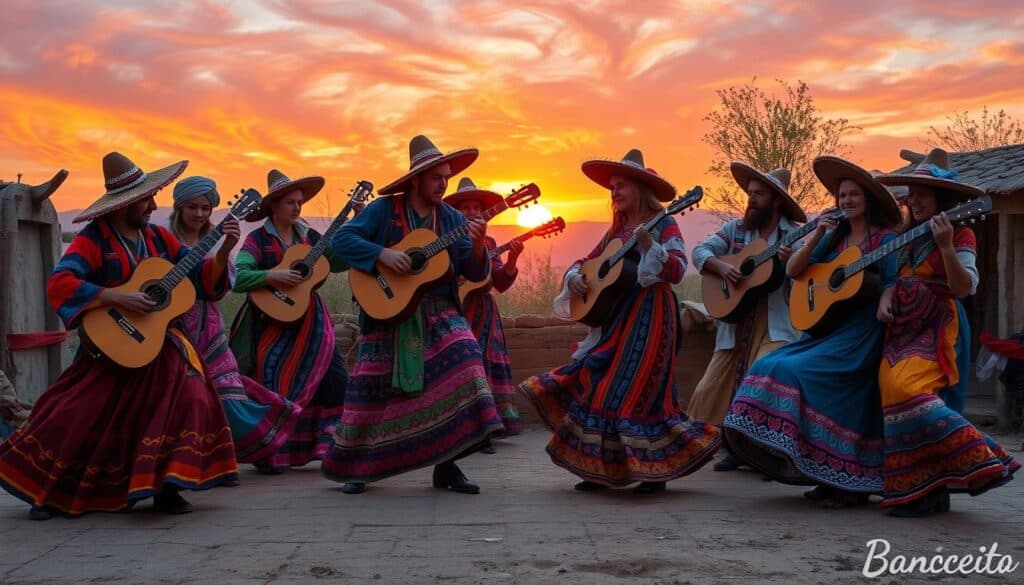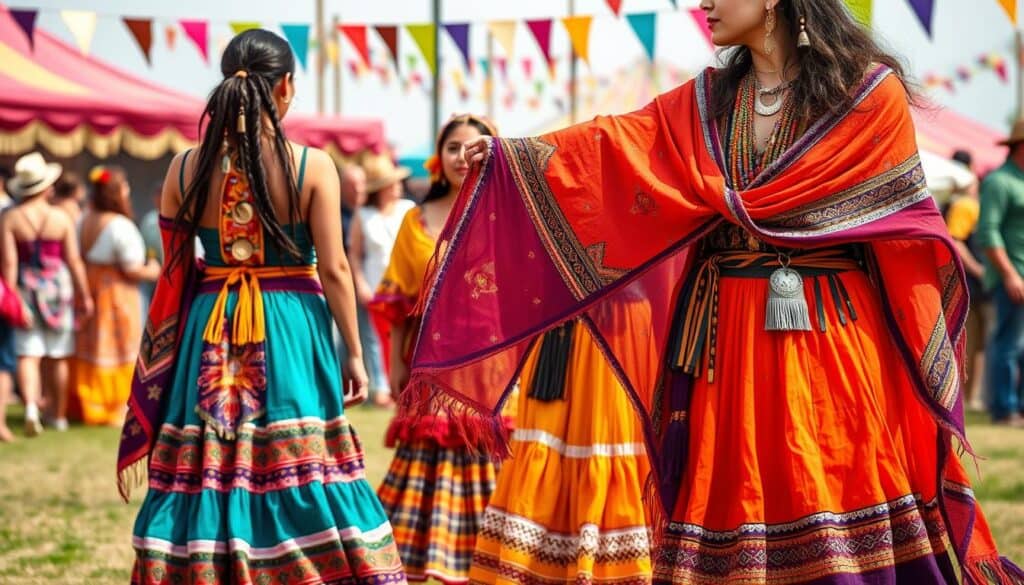Welcome to the enchanting world of the 13 Gypsies, a celebrated restaurant in Jacksonville, Florida, known for its exquisite tapas and cozy dining environment, showcasing a unique blend of gypsy clothing and bohemian fashion. The 13 Gypsies offers a captivating experience, with its primarily Spanish wine labels and limited indoor and outdoor seating, making it a must-visit destination for both locals and tourists.
In the heart of Jacksonville, the 13 Gypsies stands out with its consistently positive review ratings, described as a ‘hidden gem’. To experience the best of the 13 Gypsies, a reservation is recommended due to limited seating, and the last seating occurs an hour and a half before closing. The 13 Gypsies’ bohemian fashion sense and gypsy clothing are just a few aspects that make this place so unique and fascinating, reflecting the rich cultural heritage of the Romany people.
The Romany people, with their history dating back to their emigration from India 1500 years ago, have a distinct cultural significance, and the 13 Gypsies is a testament to their enduring legacy. With their nomadic traditions and emphasis on cleanliness practices, the Romany people have faced persecution and discrimination for centuries, making their story a compelling one to explore, especially in the context of gypsy clothing and bohemian fashion.
Key Takeaways
- The 13 Gypsies is a renowned restaurant in Jacksonville, Florida, offering a unique blend of gypsy clothing and bohemian fashion.
- The restaurant operates from Tuesday to Saturday, with a limited seating capacity, making reservations recommended.
- The 13 Gypsies features primarily Spanish wine labels, adding to its cultural significance and bohemian fashion sense.
- The Romany people have a rich cultural heritage, with a history dating back to their emigration from India 1500 years ago, influencing their gypsy clothing and traditions.
- The 13 Gypsies is a must-visit destination for both locals and tourists, providing an enchanting experience that showcases the best of gypsy clothing and bohemian fashion.
- The restaurant’s consistently positive review ratings and ‘hidden gem’ status make it a standout in Jacksonville’s dining scene, reflecting the beauty of gypsy clothing and bohemian fashion.
Introduction to the 13 Gypsies
The 13 Gypsies are a unique and fascinating group, with a rich cultural heritage and history that spans centuries. Their cultural significance is evident in their vibrant traditions, stunning gypsy clothing, and delicious cuisine. As we delve into the world of the 13 Gypsies, we will explore their history, lifestyle, and contributions to modern society.
The term “Gypsy” refers to the Romany people, a traditionally nomadic ethnic group believed to have originated from India and migrated to various parts of the world. The 13 Gypsies are a part of this larger community, with their own distinct customs and practices. Their gypsy culture is a blend of traditional and modern elements, reflecting their adaptability and resilience.
To understand the 13 Gypsies, it’s essential to explore their cultural significance and the impact they have on modern society. Some key aspects of their culture include:
- Rich musical heritage, with a unique blend of traditional and modern styles
- Vibrant clothing and accessories, reflecting their nomadic roots and cultural exchange
- Delicious cuisine, with a focus on fresh ingredients and traditional cooking methods
What Are the 13 Gypsies?
The 13 Gypsies are a small but vibrant community, known for their warm hospitality and rich cultural traditions. They are a part of the larger Romany community, with their own distinct history and customs.
Cultural Significance of the 13 Gypsies
The 13 Gypsies have a significant impact on modern society, with their unique cultural practices and traditions. They have contributed to the development of various art forms, including music, dance, and cuisine. Their gypsy culture is a valuable part of our shared cultural heritage, and it continues to inspire and fascinate people around the world.
Historical Background of the 13 Gypsies
The 13 Gypsies have a rich and fascinating historical background that spans centuries. Their origins can be traced back to India, where the Romany people originated before migrating to various parts of the world, including Europe and the Americas.
According to historical records, the Romany people were influenced by the cultures they encountered during their migrations, shaping their unique lifestyle and traditions. The 13 Gypsies, in particular, have a distinct cultural identity that reflects their historical background and origins.
Origins of the 13 Gypsies
The origins of the 13 Gypsies are deeply rooted in their Indian heritage. Over time, they developed a distinct culture that blended elements from their native India with the customs and traditions of the regions they settled in.

Understanding the historical background and origins of the 13 Gypsies is essential to appreciating their unique cultural identity and the significant contributions they have made to the world.
The Art of Gypsy Cuisine
Gypsy cuisine is a unique and flavorful blend of traditional dishes, influenced by the cultural heritage of the 13 Gypsies. The art of gypsy cuisine is characterized by the use of fresh ingredients, bold spices, and hearty portions. At the heart of gypsy cuisine are traditional dishes such as sarma, bogacha, and xaimoko, which are often served at special occasions and holidays.
Some of the key ingredients used in gypsy cuisine include potatoes, peppers, onions, garlic, and meat. However, pork and beef are rare inclusions, with traditional proteins like chicken, lamb, goat, and game animals being more common. Gypsy cuisine also incorporates Indian and South Asian influences, similar to Hungarian cuisine. The use of spices such as paprika, garlic, and bell peppers gives gypsy dishes a distinct flavor and aroma.
Traditional Dishes
Traditional gypsy dishes are often made with love and care, using recipes that have been passed down through generations. Some popular traditional dishes include:
- Sarma: a dish made with stuffed peppers, often served during holidays and special occasions
- Bogacha: a hearty stew made with ingredients like green and red peppers, tomatoes, potatoes, onions, garlic, and meat
- Xaimoko: a traditional gypsy dish made with chicken, lamb, or goat, cooked in a flavorful broth
Culinary Influences
Gypsy cuisine has been influenced by various cultures, including Indian, South Asian, and Hungarian. The use of spices, ingredients, and cooking techniques has been shaped by these influences, resulting in a unique and distinct flavor profile. The 13 Gypsies restaurant in Jacksonville, Florida, is a great example of how gypsy cuisine can be adapted and presented in a modern and innovative way.
The art of gypsy cuisine is a reflection of the rich cultural heritage of the 13 Gypsies. With its unique blend of traditional dishes, bold spices, and hearty portions, gypsy cuisine is a must-try for anyone looking to experience the flavors and traditions of this vibrant culture.
| Dish | Ingredients | Cooking Method |
|---|---|---|
| Sarma | Peppers, meat, rice, spices | Stuffed and baked |
| Bogacha | Peppers, tomatoes, potatoes, onions, garlic, meat | Stewed |
| Xaimoko | Chicken, lamb, or goat, broth, spices | Boiled |
The Music and Dance of 13 Gypsies
The 13 Gypsies have a rich cultural heritage, and their music and dance are an integral part of their traditions. Gypsy music is known for its lively rhythms and soulful melodies, often played on traditional instruments such as the violin and guitar.
Some popular traditional instruments used in gypsy music include:
- Violin
- Guitar
- Accordion
- Cimbalom
These instruments are often used to play folk dances, such as the csardas and the polka, which are popular among the 13 Gypsies.

The 13 Gypsies also have a strong tradition of dance, with many popular dances being performed at social gatherings and celebrations. Some popular dances include the flamenco and the kalbeliya, which are known for their energetic and graceful movements.
| Dance | Origin | Characteristics |
|---|---|---|
| Flamenco | Spain | Energetic and passionate |
| Kalbeliya | India | Graceful and sensual |
The music and dance of the 13 Gypsies are an important part of their cultural identity, and are often performed at social gatherings and celebrations. By experiencing their music and dance, we can gain a deeper understanding and appreciation of their rich cultural heritage.
Exploring Gypsy Fashion and Style
Gypsy fashion is a unique and vibrant aspect of the 13 Gypsies’ cultural heritage. Traditional clothing plays a significant role in gypsy fashion, with intricate patterns, colors, and fabrics that reflect their rich history and lifestyle. The Romany people are known for their stunning traditional clothing, which is often adorned with embroidery, lace, and other decorative elements.
Some common features of gypsy fashion include:
- Colorful dresses and skirts with intricate patterns and designs
- Intricate embroidery and lace work on clothing and accessories
- Use of traditional fabrics such as cotton, silk, and wool

Gypsy fashion has also evolved over time, with modern interpretations incorporating contemporary styles and materials while still maintaining the traditional essence of gypsy clothing. The 13 Gypsies’ traditional clothing is not only a reflection of their cultural heritage but also a symbol of their identity and community.
| Traditional Gypsy Clothing | Modern Interpretations |
|---|---|
| Embroidered dresses and skirts | Contemporary designs incorporating traditional embroidery |
| Colorful headscarves and shawls | Modern accessories inspired by traditional gypsy headwear |
Festivals Celebrating the 13 Gypsies
The 13 Gypsies have a rich cultural heritage, and their festivals are an integral part of their traditions. One of the most significant gypsy festivals is the Gitan Pilgrimage, which takes place in the seaside town of Les Saintes-Maries-de-la-Mer. This festival is a celebration of the Gypsies’ faith and culture, and it attracts Romanies, Manouches, Tziganes, and Gitans from all over Europe and beyond.
During the festival, participants engage in various activities, including processions, music, and dance. The festival is a time for the Gypsies to come together, pray, and fulfill their vows. It is also an opportunity for them to showcase their unique cultural traditions, such as their music, dance, and art.
Some of the notable cultural events that take place during the festival include the procession of the statuette of Black Sara, the patron saint of the Gypsies, to the sea. The festival also features a solemn mass, followed by a ceremony at the church, where the bearers go into the sea. These events are an essential part of the Gypsy pilgrimage and are a testament to the rich cultural heritage of the 13 Gypsies.
The Gitan Pilgrimage is not only a significant cultural event but also an important religious act for the Gypsies. It is a time for them to pray, seek solace, and fulfill their vows. The festival is a unique opportunity for the Gypsies to come together and celebrate their faith and culture, and it is an integral part of their traditions and lifestyle.
The Spiritual Practices of the 13 Gypsies
The 13 Gypsies have a rich spiritual heritage, with gypsy spirituality reflecting their cultural traditions. Their beliefs and rituals are unique and distinctive, from traditional healing practices to vibrant rituals and ceremonies. The Romani people prioritize cultural preservation and pass on language and beliefs to future generations.
Some of the key aspects of gypsy spirituality include the power of words to either bless or curse oneself, and the importance of spiritual cleansing with a broom. Specific omens and warnings of spirits like the Beng and Muller are taught to children at a young age. Chovihano, as shamans, interpret the will of spirits and ancestors, producing charms to aid people in everyday life.
Here are some key aspects of the spiritual practices of the 13 Gypsies:
- Traditional healing practices
- Spiritual cleansing with a broom
- Importance of words to bless or curse oneself
- Warnings of spirits like the Beng and Muller
- Role of Chovihano as shamans
The spiritual practices of the 13 Gypsies are an integral part of their cultural identity, and play a significant role in their daily lives. By understanding and respecting these practices, we can gain a deeper appreciation for the richness and diversity of gypsy culture.
| Aspect of Gypsy Spirituality | Description |
|---|---|
| Traditional Healing Practices | Use of natural remedies and spiritual rituals to heal the body and mind |
| Spiritual Cleansing | Use of a broom to cleanse the body and mind of negative energies |
| Importance of Words | Belief in the power of words to bless or curse oneself |
Modern Life and Challenges for the 13 Gypsies
The 13 Gypsies face unique challenges in modern life, including social issues such as discrimination and marginalization. In contemporary society, the Romany people continue to experience prejudice and exclusion, which can lead to a lack of access to education, employment, and healthcare.
Some of the social issues faced by the 13 Gypsies include:
- Lack of access to education and job opportunities
- Discrimination and marginalization in society
- Poverty and limited access to resources
Despite these challenges, there are efforts toward preservation of the 13 Gypsies’ culture and traditions. For example, some organizations are working to promote awareness and understanding of the Romany people’s history and experiences.
Additionally, some individuals, such as Howard Kirk of 13 Gypsies, are working to create positive change and promote social justice. By fostering a culture of fun and collaboration, they aim to create a more supportive and inclusive environment for everyone.
Overall, the 13 Gypsies face significant challenges in modern life, but there are also efforts underway to promote preservation and understanding of their culture and traditions.
| Challenge | Effort |
|---|---|
| Lack of access to education | Organizations promoting awareness and understanding |
| Discrimination and marginalization | Individuals working to create positive change and promote social justice |
| Poverty and limited access to resources | Efforts to create a more supportive and inclusive environment |
Representation in Media and Pop Culture
The 13 Gypsies have been a part of media representation for decades, with their unique culture and lifestyle being portrayed in various films and books. Media representation plays a significant role in shaping public perception, and the 13 Gypsies are no exception. In recent years, there has been a shift towards more nuanced and accurate depictions of the 13 Gypsies in pop culture.
Some notable examples of media representation include films and books that showcase the rich cultural heritage of the 13 Gypsies. These representations have helped to raise awareness about the community and their lifestyle. However, it is essential to note that media representation can also perpetuate stereotypes and reinforce negative attitudes towards the 13 Gypsies.
Key Films and Books Featuring the 13 Gypsies
Several films and books have featured the 13 Gypsies, including documentaries and fiction stories. These representations have helped to humanize the community and showcase their struggles and triumphs. Some examples include:
- Documentaries that explore the history and culture of the 13 Gypsies
- Fiction books that feature Gypsy characters and storylines
- Films that portray the struggles and challenges faced by the 13 Gypsies
Impact on Public Perception
The impact of media representation on public perception cannot be overstated. Research has shown that heavy viewers of television are more likely to believe ethnic stereotypes, and viewers of comedic sketches perpetuating negative stereotypes are more likely to judge news subjects by race. It is essential to promote accurate and nuanced representations of the 13 Gypsies in media and pop culture to combat negative stereotypes and promote understanding and acceptance.
| Media Representation | Impact on Public Perception |
|---|---|
| Accurate and nuanced representations | Promote understanding and acceptance |
| Stereotypical and negative representations | Reinforce negative attitudes and stereotypes |
How to Experience the Culture of the 13 Gypsies
To truly experience the captivating culture of the 13 Gypsies, consider visiting their vibrant communities across the world. Gypsy communities often welcome visitors with open arms, inviting them to participate in traditional festivals, music, and dance performances. This unique opportunity allows you to witness firsthand the vibrant customs and lifestyle that define the 13 Gypsies.
When engaging with the Gypsy culture, it’s essential to do so respectfully. Approach each interaction with an open mind and a genuine interest in learning about their rich heritage. Respect their traditions, avoid stereotypes, and be mindful of any cultural sensitivities. By embracing the diversity and authenticity of the 13 Gypsies, you’ll gain a deeper appreciation for their remarkable legacy.
